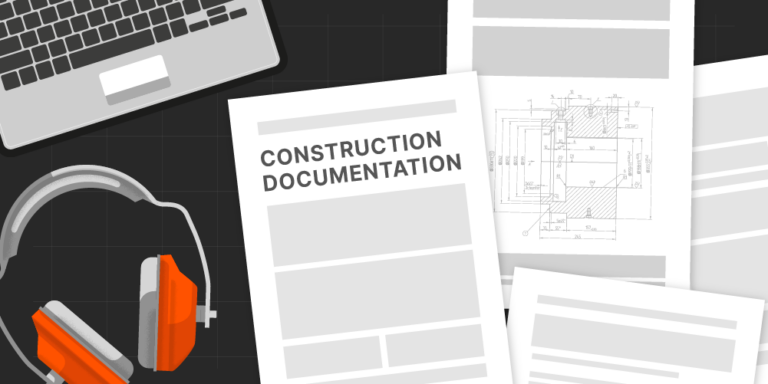— 9 min read
Document Control, Mastered: Blueprints, Binders & the Cloud
Last Updated Apr 24, 2025
Last Updated Apr 24, 2025

In construction, poor document control is more than a hassle—it’s a liability. Mismanaged documents can delay builds, drive up costs, and cause security and compliance issues. It’s a challenge facing project managers, contractors, and owners alike across Australia and New Zealand. But there’s good news: when done well, document control streamlines communication, reduces risk, and keeps every team member on the same page. As projects become more complex and teams more dispersed, cloud-based solutions, automation, and AI-driven tools are revolutionizing the way construction companies manage their documents—making best practices more achievable than ever.
Table of contents
What is Construction Document Control?
Construction document control manages, stores, tracks, and distributes project documents while keeping confidential information secure and accessible.
This approach keeps all stakeholders - from project managers to subcontractors - aligned with the latest project data. It prevents miscommunication and simplifies legal compliance by organising everything in one place.
Why Document Control Matters
Failing to implement proper document control risks sending projects spiralling out of control. Effective document control prevents teams from working with outdated plans, misplacing specifications or contracts, overlooking legal requirements, and experiencing costly delays.
Document control serves four core functions:
Version Tracking
Poor version management leads to teams working from outdated drawings, causing incorrect installations and material waste. Version control ensures teams always access the most current documents, reducing miscommunication and preventing expensive mistakes.
Access Protection
Construction documents often contain contract details, financial agreements, and safety reports. Without access control, unauthorised personnel might view or modify sensitive files, creating legal risks and potential contract disputes.
Workflow Standardisation
Unstructured workflows often cause bottlenecks in document approvals, delaying key project milestones. Standardised document workflows automate approvals, track changes in real-time, and keep projects moving without administrative delays.
Compliance Monitoring
Missing or outdated compliance documents result in fines or safety risks. Well-managed document control systems track licenses, certifications, and inspection records to ensure compliance and audit-readiness.
Modern cloud-based document management systems (DMS) enable real-time collaboration, automated tracking, and remote accessibility, reducing delays and risks on complex projects.
Essential Construction Documents
Construction document control covers all paperwork related to a single project. Each document plays a distinct role in ensuring project accuracy, risk management, and legal compliance. These documents fall into five main categories:
Design and Technical Documents
These documents translate project ideas into reality with correct specifications, dimensions, and structural guidelines:
- Architectural Drawings and Plans → Blueprint layouts and technical specifications
- Engineering Reports → Site conditions, structural calculations, and safety assessments
- BIM Models → Digital representations linking 3D designs with documentation
Legal and Contractual Documents
Standardised contracts set expectations between project stakeholders, reducing dispute risks:
- NEC Contracts → Flexible agreements for engineering and public-sector projects
- Subcontractor Agreements → Define obligations between general contractors and specialist trades
- Change Orders and Variations → Document mid-project modifications
Compliance and Regulatory Documents
Construction projects must meet strict National Construction Code (NCC) and safety regulations:
- Planning Permissions and Building Approvals → Required before work can legally begin
- Health and Safety Reports → Risk assessments, method statements, and site safety plans
- Environmental Impact Assessments → Ensures projects meet sustainability goals
Financial and Procurement Documents
Properly managed financial documents prevent cost overruns and improve budgeting accuracy:
- Bills of Quantities (BoQ) → Breaks down materials, labour, and associated costs
- Purchase Orders and Supplier Invoices → Tracks procurement and payments
- Budget Reports and Forecasting → Ensures financial control
Project Communication Records
Document control ensures clear project communication:
- Requests for Information (RFIs) → Clarify design and technical details between teams
- Meeting Minutes and Progress Reports → Log project updates, site activity, and action points
- Incident Reports → Record safety breaches and site accidents for legal compliance
Who Manages Construction Document Control?
Proper document control requires robust management. Depending on project size and complexity, different team members implement document workflow, version tracking, and compliance:
Document Controller
The document controller organises, maintains, and distributes project documents by:
- Ensuring all project documents stay properly stored, updated, and accessible
- Managing version control to prevent work with outdated files
- Tracking approvals and workflow processes to maintain momentum
- Maintaining compliance records to meet legal and safety standards
Project Manager
While document controllers focus on document management, project managers ensure document workflows support overall project goals by:
- Ensuring teams follow standard document control procedures
- Approving critical documents like contracts and compliance records
- Coordinating with subcontractors and suppliers to maintain updated documentation
Site Administrator or Office Manager
On larger projects, site administrators or office managers assist with day-to-day document tracking and distribution by:
- Uploading and organising site documents (site diary, safety reports)
- Ensuring on-site teams access the latest approved documents
- Coordinating document requests between field teams and office staff
Cloud-Based Document Control Benefits
Traditional construction document management relied on physical paperwork and local servers, making it difficult to track updates and increasing risks of lost, outdated, or inaccessible files. Cloud-based document control systems transform how construction teams store, share, and manage information, offering efficiency that paper and spreadsheets cannot match:
Real-Time Access and Collaboration
With cloud-based systems, teams access project documents from anywhere - on-site, in the office, or remotely:
- Eliminates waiting for updated files - everyone sees changes instantly
- Enables faster decision-making and troubleshooting, reducing delays
- Reduces reliance on multiple emails for document sharing, preventing confusion
Improved Version Control and Accuracy
Outdated drawings or incorrect specifications lead to costly mistakes and rework. Cloud-based systems guarantee:
- Automatic version tracking - the latest document is always available
- Revision history logs showing who made changes and when
- Fewer errors and disputes by maintaining a single information source
Enhanced Security and Access Control
Construction documents often contain sensitive information like financial contracts and safety reports. Cloud-based solutions offer:
- Permission-based access so only authorised users can view or edit files
- Encrypted data storage protecting documents from cyber threats
- Backup and disaster recovery preventing data loss from hardware failures
Technology Transforming Document Control
Technology has revolutionised how construction teams manage and share project documents, improving collaboration and security while reducing manual admin work and human error:
Cloud-Based Storage and Collaboration
- Provides real-time access to the latest documents from any location
- Ensures automatic syncing and updates so teams always work from correct versions
- Reduces email chains and document duplication, improving workflow efficiency
BIM (Building Information Modelling)
- Integrates 3D models with project documents to streamline planning
- Enables faster design revisions, preventing use of outdated blueprints
- Improves coordination between architects, engineers, and contractors
AI-Powered Automation and Predictive Analytics
- AI-driven document sorting and tagging simplifies file organisation
- Predictive risk analysis detects compliance gaps before they become issues
- Automated document approvals and workflow tracking reduce admin delays
Mobile Apps and On-Site Access
- Enables instant retrieval of permits, contracts, and RFIs on-site
- Reduces paper-based reporting needs, improving accuracy
- Allows real-time photo uploads and document markups, ensuring transparency
Cybersecurity and Access Control
- End-to-end encryption secures financial, legal, and design documents
- Multi-factor authentication prevents unauthorised access
- Audit trails and automated backups ensure local regulatory compliance
Compliance and Audit Readiness
Construction projects face heavy regulation, and missing documentation can have legal implications. Cloud-based systems:
- Maintain digital audit trails, ensuring compliance with ANZ building regulations.
- Enable faster document retrieval for inspections or disputes
- Help maintain health and safety compliance with easy access to permits, risk assessments, and incident reports
The scope of modern construction management has made cloud-based document control essential for reducing delays, guaranteeing security, and keeping projects on track and legally compliant.
Document Organisation Best Practices
Managing construction documents extends beyond storage - it ensures the right people access the right information at the right time. Follow these best practices to keep construction documents accessible:
Create Clear Naming Conventions
A consistent file-naming system prevents confusion and makes documents easy to find:
- Use descriptive, structured file names (e.g., 'ProjectName_Phase_DocumentType_VersionDate.pdf')
- Avoid ambiguous names like 'final.doc' or 'update1.pdf'
- Include revision numbers to track updates (e.g., 'ProjectName_B1_Rev02.pdf')
Build Logical Folder Structures
A clear, logical folder structure keeps documents organised by:
- Project Phase (pre-construction, execution, closeout)
- Document Type (contracts, RFIs, drawings, safety reports)
- Stakeholders (subcontractors, architects, clients)
Enforce Version Control
- Use cloud-based systems to automatically track revisions
- Archive old versions while keeping them accessible if needed
- Assign permissions to prevent unauthorised edits to critical files
Automate Document Workflows
- Set up automated approval processes to reduce manual handling
- Use notifications and tracking logs to keep teams updated on document status
- Implement role-based access controls to maintain security
Schedule Regular Document Audits
- Conduct routine reviews to remove outdated files and maintain accuracy
- Keep compliance documents (permits, certifications) updated
- Designate a document control lead to oversee document integrity
Document Security Essentials in Construction
Construction projects involve numerous confidential and legally binding documents, including contracts, financial records, design plans, and safety reports. Without adequate security measures and access control, sensitive information risks exposure to unauthorised readers, data breaches, or compliance violations:
Role-Based Access Control (RBAC)
- Restricted Access Levels: Ensures only authorised personnel can view, edit, or approve specific documents
- Custom Permissions: Limits document access based on job role (e.g., subcontractors only see relevant plans)
- Automated Access Logs: Tracks who accessed or modified documents, improving accountability
Data Encryption and Secure Storage
- End-to-End Encryption: Protects documents from cyber threats during storage and file transfers
- Cloud-Based Backups: Prevents data loss from accidental deletions or system failures
- Multi-Factor Authentication: Adds extra security when accessing sensitive files
Audit Trails and Compliance Tracking
- Automatic Audit Logs: Maintains a detailed history of document modifications for compliance
- Regulatory Compliance: Helps firms meet data protection laws, GDPR, and industry security standards
- Document Expiry Alerts: Notifies teams when permits, certifications, or compliance documents need renewal
Real-Time Communication Benefits
In construction's complex, regulated environment, real-time communication in document control keeps projects moving forward. Project teams need instant access to the latest documents - from updated designs to revised contracts or safety reports - to maintain progress:
Prevent Costly Errors
- Cloud-based document control ensures all stakeholders always have access to the latest revisions
- Automated alerts notify teams when critical documents change
- Eliminates version confusion, preventing teams from using outdated information
Ensure Seamless Collaboration
- Real-time access allows contractors, architects, and engineers to review and comment on documents instantly
- Integrated mobile solutions enable teams to upload and retrieve files directly from jobsites
- Faster approval workflows prevent decision-making bottlenecks
Enhance Risk Management
- Live tracking of permits, inspections, and compliance reports prevents overlooked details
- Automated audit trails document every change for accountability and regulatory compliance
- Clear documentation of all communications reduces legal risks and prevents disputes
The Future of Document Control
In an industry where miscommunication and outdated information lead to costly errors, effective construction document control is paramount. By leveraging cloud-based systems, automation, and real-time collaboration, firms can streamline workflows, enhance security, and improve efficiency across all project stages.
Document management extends beyond organising files. Today it ensures the right people have instant access to accurate, up-to-date information whenever needed. Firms embracing digital solutions, standardised processes, and secure access controls reduce risks and improve compliance while positioning themselves for greater productivity and long-term success.
As construction projects grow more complex, technology-driven document control will continue shaping the industry, helping businesses thrive in an increasingly competitive sector.
Categories:
Tags:
Written by
Sean Doran
Sean is a Solutions Engineer at Procore with a background in civil engineering and construction management, with over a decade of experience across project management, engineering, and functional consulting. He’s held various site based roles for Multiplex as well as Project Manager at TSA Management and has a deep understanding of cloud-based construction platforms, including Procore. With a passion for solving complex challenges and a commitment to continuous learning, Sean enjoys sharing practical insights to help construction professionals improve processes, embrace innovation, and stay ahead in a rapidly evolving industry.
View profileExplore more helpful resources

Construction Progress Claims: Keeping Cash Flowing
In construction, steady cash flow is critical—and progress claims help make that possible. These claims enable staged payments based on work completed, rather than waiting until project completion. In this...

Construction Analytics: The Key to Smarter Decision-Making
Data is everywhere in construction—embedded in schedules, site activity logs, safety reports, and cost tracking tools. Yet despite the abundance of available information, many construction decisions still hinge on gut...

Construction Document Management: The Challenges and Benefits of Embracing a DMS
Every construction project begins, continues, and ends with a mountain of paperwork. From initial bidding documents to contractor agreements, blueprints, variation orders, inspection reports, on and on it goes. And...

Cash Flow Forecasting in Construction: How to Stay Ahead of Funding Gaps and Protect Project Performance
Cash shortfalls are a leading cause of stalled projects, unpaid contractors, and budget blowouts in construction. Without a clear forecast of how cash will flow in and out over time,...